Did you know that over 60% of all calls made to businesses are abandoned? If your business is not doing everything possible to reduce the call abandonment rate, you could be losing potential customers and revenue. In this blog post, we will discuss the causes of call abandonment and some tips on how to reduce it. Stay tuned!
What is Call Abandonment Rate?
The call abandonment rate is an important metric that measures the percentage of customers who hang up before a service representative answers their calls. It reflects the effectiveness of your customer service team in resolving inquiries efficiently and preventing customers from getting frustrated and leaving the call.
Most consumers consider an immediate response to customer service inquiries as “important” or “very important.” As such, a high call abandonment rate signals that customers need to receive the value they expect from their service experience. A high call abandonment rate will lead to more customers who still need more satisfaction with their experience and still need assistance. This shows the importance of providing immediate responses to ensure more satisfaction with their experience and customer satisfaction.
Why Is It Important For Startups To Track Call Abandonment Rate?
The call abandonment rate is a key metric that all startups should track to measure customer service performance. For companies offering phone support, Call Abandonment Rate is a key customer service KPI that needs monitoring on an ongoing basis.
A high call abandonment rate is usually due to customers being on hold for extended periods, resulting in poor customer satisfaction. Other factors contributing to a high abandonment rate include ineffective IVR (Interactive Voice Response) menus or excessive transferring between departments.
A low Call Abandonment Rate (generally around 5%) indicates that calls are being answered promptly. Fewer abandoned calls mean the IVR settings and transfer process are configured correctly, and customers find them easy to understand.
It is important to note that having a low abandonment rate doesn’t necessarily mean customers are getting good service. The call may not satisfactorily resolve their query, or the customer might need multiple calls to resolve their issue. Therefore, companies should focus on providing an excellent customer experience to ensure that queries are dealt with efficiently and effectively.
Common pitfalls when measuring call abandonment rate
When measuring call abandonment rate, there are some common pitfalls to be aware of.
Treating Hang-Ups as Abandoned Calls
When calculating an abandon rate for your contact center, it is common practice to exclude short calls from the rate. However, there is no consensus on what constitutes a “short call,” and it is essential to decide on an appropriate cut-off time. A histogram of different call durations can help determine a good cut-off.
There is an informative discussion on this topic available at ICMI.com. Additionally, there are various ways to account for short calls when calculating the rate, each of which has its own implications. Hang-ups are sometimes abandoned calls, as customers may take a break to review their notes before continuing the conversation. However, if a customer does not reconnect within a reasonable timeframe, the call should be considered abandoned.
This post by Sergey Menshikov looks further into these different options. Understanding how short calls are counted can ensure that your abandon rate is accurately calculated.
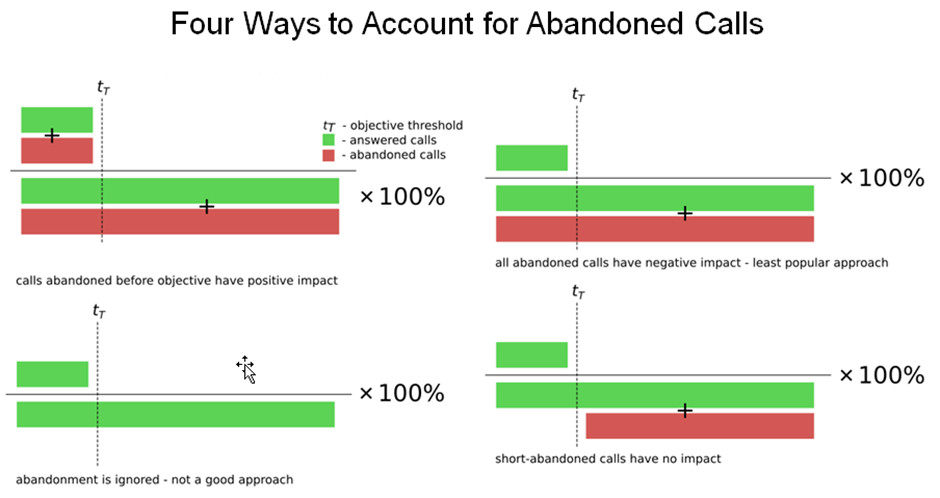
Overestimating Abandoned Calls
It is essential to make sure all abandoned calls are truly abandoned instead of being transferred or put on hold. Incorrectly including transferred calls in the abandon rate can significantly distort the results and make it appear that more callers are abandoning calls than is actually the case.
Ignoring Abandonment Time Thresholds
Most contact centers set an abandonment threshold for their calls, such as five or ten seconds. Calls abandoned after the set threshold will not be counted toward the abandonment rate. However, it is possible to overestimate the abandonment threshold, resulting in an accurate rate. It is important to measure the actual abandonment rates and adjust the thresholds accordingly.
How do you calculate Call Abandonment Rate?
Here’s the formula to calculate the call abandonment rate. Divide the total number of calls abandoned by the calls received.
[No. calls Abandoned / Total no. calls] × 100 = Abandonment Rate (%)The Call Abandonment Rate is typically expressed as a percentage, so the formula above multiplies the ratio by 100. Let’s give a quick example.
Say a call center received 300 calls this month, and the team handled almost 280 of them. The call abandonment rate is about 6.7% by using the above formula:
300 – 280 = 20; 20/300 = 6.7%
What are the different ways of calculating the call abandonment rate?
In certain situations, it may be necessary to calculate the number of abandoned calls by subtracting the number of answered calls from the overall call volume.
No. calls abandoned = No. calls received – No. call answered
Resulting in:
[No. calls received – no. Calls answered / Total no. calls] × 100 = Abandonment Rate (%)When determining Call Abandonment Rate, it’s common practice to exclude calls that are particularly brief to prevent misdials and other unintended telephone calls from skewing the numbers. At the same time, it is essential to ensure that the metric is adequately affected by omitting too many calls. It is also essential to track the amount of callers who hang up while navigating through a self-service menu since this should not be calculated in the Call Abandonment Rate but rather seen as a failure of the process.
What factors affect Call Abandonment Rate?
The call abandonment rate is affected by several factors. Here are some common factors:
Queue time:
Customers who wait excessively long in the queue before their call is answered are more likely to abandon the call. Long queue times can be caused by too few agents available to answer calls, a complex IVR (interactive voice response) system, or a lack of call routing optimization.
Call volume:
High volumes of incoming calls can also lead to increased abandonment rates. In these cases, the call center needs to ensure that they have adequate resources to handle the call flow.
System or service issues:
System or service issues, such as an outdated system or poor training on the customer service staff members, can also lead to customers abandoning their calls.
Poor customer experience:
If customers have had a previous negative experience with the company, they may be more likely to abandon their calls. Poor customer service, long wait times, and lack of helpful information can all contribute to an unsatisfactory customer experience.
Inaccurate system information:
If the IVR or other automated systems provide accurate information, customers may become satisfied and continue their calls.
What is a good call abandonment rate?
On average, call centers should aim to maintain an abandonment rate of between 5% and 8%. A 2021 global benchmarking report from Talkdesk found that the average abandonment rate is 5.91%.
The pandemic has significantly impacted call centers, causing customers to encounter longer wait times and higher abandonment rates. However, the exact call center abandonment rate may vary depending on the industry, as customer needs can differ depending on the product or service offered. Knowing these customer needs can help call centers better manage their abandonment rate and meet customer expectations.
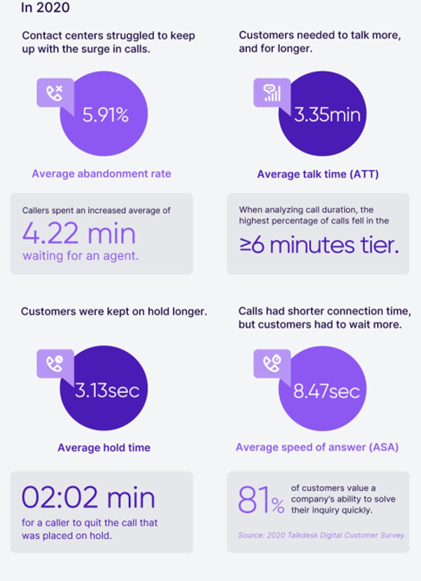
Research by Talkdesk reveals the standard for abandonment rates across software, retail, and more industries. By understanding these benchmarks, businesses can identify how their call center performance compares to that of their competitors and take action to improve their customer experience.
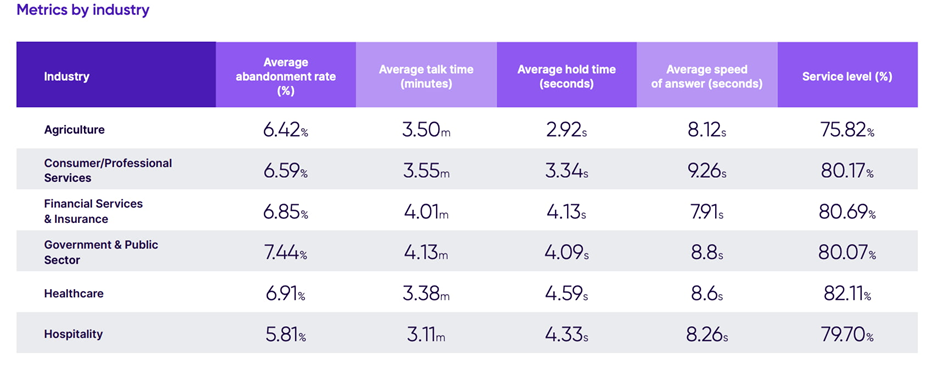
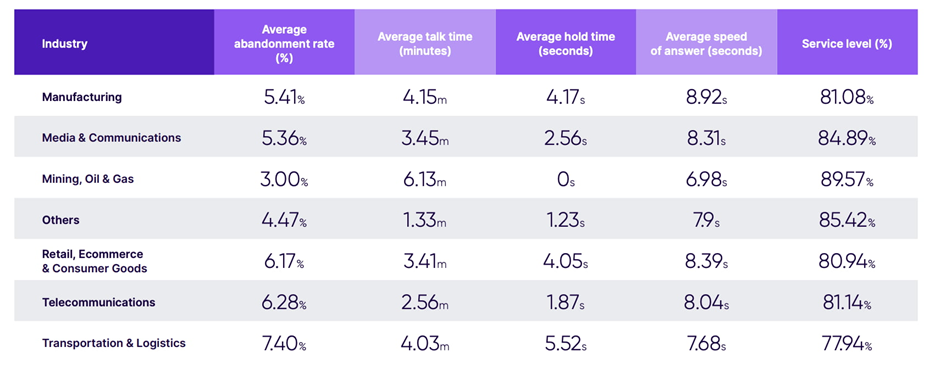
Monitoring call abandonment rates is important for understanding the effectiveness of your customer service strategies. You can use the metrics above as a reference when evaluating your own abandonment rate. Generating reports from call data will provide valuable insight into which strategies need to be adjusted and what strategies are working best. Analyzing this data can help you understand customer behaviour and manage customer expectations accordingly.
Distinguishing between call types and intent
It is important to note that customers make different types of calls, and each has a distinct likelihood of being abandoned. For instance, customers calling for technical support with a problem are less likely to hang up than those who call sales lines. Here’s a graph showing how call abandons are affected by sales and technical support:
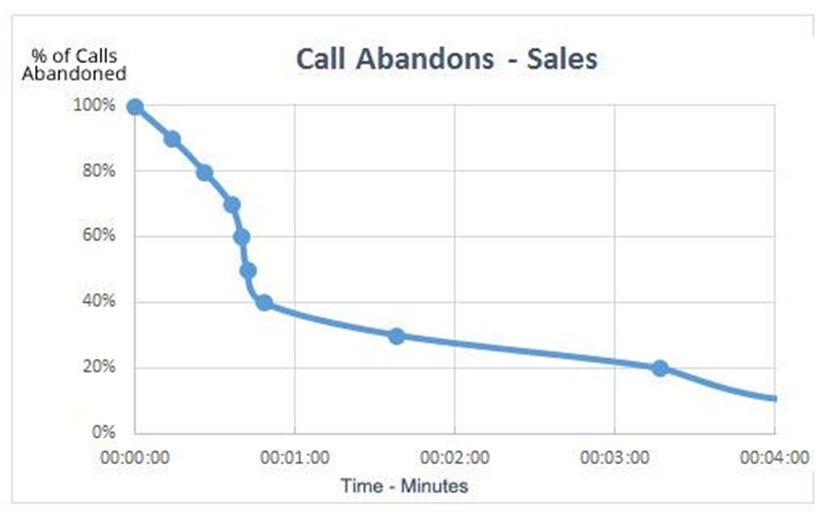
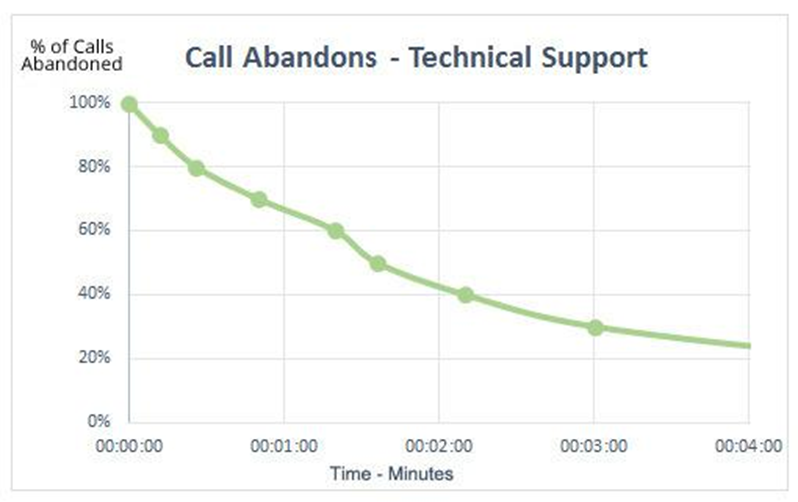
What are tips to decrease Call abandonment rates?
Here are the tips to decrease call abandonment rates:
Reduce Wait Times:
One of the leading causes of customer call abandonment is long wait times. To reduce wait times, ensure that you have sufficient customer service representatives available to assist customers with their inquiries. Additionally, automate some processes to help reduce wait times and improve efficiency. For example, an interactive voice response (IVR) system can help direct customers to the right department quickly.
Give Customers an Option to Leave a Message:
Offering customers an option to leave a message when no agent is available or if they cannot wait for an agent can also reduce call abandonment rates. This way, customers will not have to wait in queue for long, and the customer service agent can call them back when available.
Set Reasonable Service Goals:
Many companies often set unrealistic goals for their customer service staff. This leads to increased pressure on customer service agents resulting in customers hanging up before they get an answer to their query. To reduce call abandonment rates, ensure that you set realistic service goals that can be achieved quickly.
Monitor and Track Performance:
It is essential to monitor customer service performance on an ongoing basis to identify any issues causing customers to hang up before speaking with an agent. Analyzing data from each call will help you understand which processes need improvement so that you can take steps to improve the customer service experience.
Show Appreciation:
Appreciating customers for their loyalty greatly improves customer satisfaction and reduces call abandonment rates. Make sure you recognize your customers when they take the time to give feedback or make a complaint, as this will help them feel valued and more likely to stay on the call. Additionally, reward customers for their loyalty with discounts or special offers to encourage them to keep calling your business.
Tools to measure Call Abandonment Rates
Fortunately, there are a number of tools that can help measure call abandonment rates. These include:
Call Tracking Software:
This type of software records and stores data related to incoming and outgoing calls, such as the caller’s number, the duration of the call, and whether it was answered. This data can be used to identify trends in call abandonment, allowing you to make more informed decisions about how best to manage your customer service.
IVR Systems:
Interactive Voice Response (IVR) systems are automated phone systems that allow customers to complete tasks such as making payments or requesting information without speaking to a customer service representative. They can also be used to track call abandonment rates, as customers are asked to make choices at various points along the way, and the system can detect when someone hangs up before completing a task.
Call Monitoring Tools:
These tools allow customer service representatives to monitor customer conversations in real-time, so they can intervene if necessary. They also provide insights into call abandonment trends and key performance metrics, such as average call handling time.
Using these tools, businesses can take proactive steps to reduce call abandonment rates and ensure better customer service.
Conclusion
In spite of the high call abandonment rate, you can use a few psychological tricks to increase inhibition control and make sure that your customers stay on the line. By raising self-awareness about why people are abandoning calls in the first place, you can adapt your sales strategy and improve customer retention. And remember – even if someone does abandon their call, there’s always a chance to win them back with a well-crafted callback campaign.

